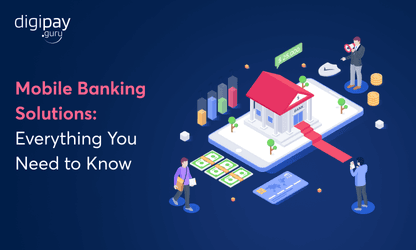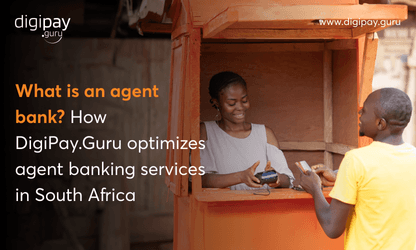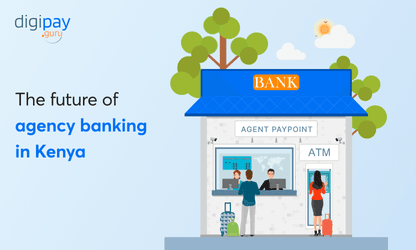Branchless banking—or “agency banking,” as it’s often called—is a game-changer for financial inclusion. Imagine accessing your bank account, withdrawing cash, or making payments without ever setting foot in a physical bank branch. This is the vision that a branchless banking solution brings to life.
It’s an opportunity for businesses like yours to extend their banking/financial services to customers who are unbanked, underserved, or live in untapped or rural regions. But how does branchless banking do that, and why is it so important for financial inclusion? This blog will answer these questions and more.
In this blog, you will explore:
- The basics of branchless banking
- How can branchless banking overcome the challenges of traditional banking?
- How branchless banking facilitates financial inclusion
- Benefits of branchless banking for financial institutions
- Cost and scope of branchless banking and more…
Let’s begin with an overview of branchless banking!
Branchless banking – A brief overview
Let’s start by explaining to you what branchless banking is.
What is branchless banking?
In layman’s terms, branchless banking is nothing but banking without going to a bank. Most rural areas are inaccessible for banking services; hence, this comes into the picture.
Talking about the detailed definition, we can say that branchless banking consists of third-party bank agents, for example, a nearby retailer who acts as a “Human ATM." It enables customers to access formal banking services via these agents. The agents use the mobile app on their smartphones to facilitate various banking transactions like cash deposits or withdrawals.
The major point that differentiates traditional banking from branchless banking is physical presence. Traditional banking has regional headquarters and branches located across the countries where it operates.
On the other hand, branchless banking portals allow customers to view their balances, transfer money, open new accounts, and more without visiting the physical bank branch. For businesses like yours, opening a branch in every place is not feasible + costly. So, branchless banking is a savior. Mobile banking, Internet banking, and Neobanking are the prime branchless banking types.
Now that we have a clear view of branchless banking, let us check out the recent scenario of branchless banking.
How it works
Branchless banking is simple in functioning:
-
The branchless banking model operates on a blend of digital platforms, local agents, and mobile banking.
-
Banks set up a network of agents in various locations, such as local shops or kiosks, where people can perform transactions.
-
Through digital wallet solutions and mobile banking apps, these services become accessible to anyone with a mobile phone.
-
With API integration, these solutions can connect seamlessly with other financial systems, making transactions smooth and efficient.
The current scenario in branchless banking
Branchless banking is booming, especially in countries with large rural populations.
But, nearly 1.4 billion people globally are still unbanked! This scenario can become totally opposite with agency banking. Don’t believe me? Here’s proof – according to research by Goodwood, 96% reported that agency banking leads to financial inclusion.
Agency banking has become more synonymous with mobile money. Financial institutions now use mobile and digital wallets to provide services to the unbanked. This offers a low-cost and high-access alternative to traditional banks.
In this landscape, branchless banking platforms are emerging as crucial tools for banks aiming to achieve financial inclusion. Let us now understand how branchless banking can help you to cope with the limitations of traditional banking.
Let us now understand how branchless banking can help you to cope with the limitations of traditional banking.
Branchless banking Vs traditional banking
Branchless banking has made it easy to extend banking services for traditional banking system owners. But, that is not it. There are certain aspects of both these types of banking that make one different from another.
Let’s see them:
| Feature | Traditional Banking | Branchless Banking |
|---|---|---|
| Physical presence | Required | Not required |
| Operational costs | High | Low |
| Accessibility for rural areas | Limited | High |
| Convenience | Fixed hours | Flexible, 24/7 |
Branchless banking not only offers a more flexible model but also reduces operational costs for banks, which can be passed on as savings to customers.
How branchless banking can overcome the challenges of traditional banking?
For people without easy access to a physical bank, a branchless bank is a lifeline. Here’s how it addresses some of the biggest obstacles in traditional banking.

Rapid financial inclusion
Financial inclusion has always been a top priority of a majority of countries across the globe. However, it is quite challenging to reach out to the under-banked rural population. And opening bank branches often comes with enormous costs. Plus, for customers, it's challenging to travel too far.
Branchless banking eliminates the need for physical infrastructure and allows banks to offer services in places they could not reach before. Today, a customer can easily access branchless banking services by visiting its nearest agent. In this way, more and more customers can now access hassle-free banking services.
Increased adoption
Less adoption of banking services in rural, unbanked, and underserved areas is one of the biggest reasons that gives birth to the challenge of financial inclusion. With the rise of smartphones, the adoption of mobile banking solutions is accelerating.
You as a bank or financial institution can implement a mobile banking solution, and assign various agents in the unbanked regions. These agents can offer banking services in these areas and this way the adoption of banking services will increase. This will ultimately lead to an increase in financial inclusion.
Enhancing financial literacy and trust
Financial inclusion isn’t just about access; it’s also about understanding. By working closely with local agents, banks can provide a personal touch and educate people on banking basics. This creates a culture of trust and comfort, which is essential for first-time users of financial services.
Building partnerships with local agents
Agents are the backbone of the branchless banking model. They’re often local shop owners or community members whom customers trust, making transactions feel secure and familiar. This partnership is crucial for banks to build a local presence and reach people on a personal level.
Leveraging mobile payments and eWallets
Digital wallets and mobile payments are integral to branchless banking. With a simple mobile device, users can transfer money, pay bills, and even save funds securely. eWallets eliminate the need for cash and provide a secure way to store and transfer money which promotes greater financial control.
7 key benefits of branchless banking
Branchless banking brings a host of advantages for businesses like yours, which allows you to serve more people while operating more efficiently.

Let us now look at the amazing branchless banking benefits:
Lower operational costs
One of the top advantages of branchless banking for your business is the reduction in operational costs. Without the need for physical branches, you can significantly lower overhead expenses like rent, utilities, and maintenance.
The branchless banking model allows you to rely on agent networks or digital kiosks instead, which drastically cuts down costs and improves your financial efficiency.
Greater customer experience and satisfaction
By offering branchless banking, you make banking more accessible and convenient for your customers. With agents located in local communities and services available 24/7 through digital platforms, customers have the freedom to bank whenever and wherever they need.
This enhanced accessibility leads to boosted business revenue and higher customer satisfaction as customers no longer face the limitations of fixed branch hours or long-distance travel.
Customer expansion and retention
Branchless banking helps you reach new customer segments who may not have been able to access traditional banking services. By offering financial services in remote or underserved areas, you expand your reach to the unbanked and underbanked populations.
This not only brings in new customers but also increases retention by providing a convenient service model that meets their everyday needs.
Top security
With digital safeguards like two-factor authentication and secure API integration, branchless banking platforms offer top-notch payment security to protect customer data and transactions. This allows you to assure your customers that their information is safe thereby building trust and strengthening your institution’s reputation.
Faster onboarding with digital KYC
Branchless banking makes it easier and quicker to onboard new customers through Digital KYC (Know Your Customer). Digital KYC streamlines the verification process, which allows customers to open accounts and access services without visiting a branch.
This not only saves time for your customers but also reduces the operational load on your business. All this makes onboarding efficient and seamless.
Supports multiple transactions
With a branchless banking solution, your business can support a wide range of transactions, from cash deposits and withdrawals to fund transfers and bill payments.
Besides this, a branchless banking platform supports multiple cutting-edge contactless payment solutions such as NFC, QR Codes, OCR, mPOS, mobile wallets, etc. to avoid direct human contact.
Digital wallets and mobile payments can further extend your offerings, thereby making it possible to deliver multiple services through a single platform. This versatility meets various customer needs and creates a one-stop solution for all their financial transactions.
Data-driven insights
In branchless banking, agents provide an attractive opportunity for banks to get customer data such as their frequency of transactions and purchasing habits.
By analyzing this data, you can better understand customer needs, identify trends, and make data-driven decisions to enhance your services. These insights allow you to offer personalized experiences, improve customer satisfaction, and adapt quickly to market changes.
Moreover, branchless banking solutions provide agents with impeccable reporting and analytics capabilities too.
Cost and scope of branchless banking
Branchless banking solutions present an affordable alternative for financial institutions. By partnering with local agents and using mobile technology, banks can reduce the cost of reaching underserved markets.
In addition to that, the scope of branchless banking is broad, covering everything from payments and transfers to digital KYC, which makes it ideal for a variety of financial needs.
Agent network setup and training
Factors impacting the cost of implementing agency banking solutions in your business:

1. Technology and software development
Robust software, mobile apps, and secure API integration come with initial and ongoing costs.
2. Agent network setup and training
Recruiting and equipping agents requires upfront investment in training and technology.
3. Security and compliance
Cybersecurity, fraud prevention, and digital KYC are essential investments for secure operations.
4. Customer support infrastructure
Remote support tools, call centers, and chatbots improve customer service but add to setup costs
5. Marketing and customer education
Educating customers and promoting branchless services requires a dedicated marketing budget.
Future of branchless banking
The future of branchless banking is promising. With advancements in mobile banking solutions, API integration, and automated financial services, branchless banking is evolving to serve even more needs.
Emerging technologies like AI, blockchain, and biometrics will enhance security, streamline operations, and improve personalization in branchless banking. Additionally, the integration of mobile wallets and real-time payment systems will make financial services more accessible to underserved regions, thereby driving financial inclusion on a larger scale.
As technology advances, branchless banking will integrate with more services, which will make it the go-to solution for financial inclusion globally.
Conclusion
Branchless banking is transforming the financial landscape by making banking accessible to everyone, everywhere. It’s a practical and cost-effective way for traditional banks and fintechs to promote financial inclusion.
By using branchless banking platforms, you can lower costs, increase accessibility, and build trust in underserved communities. For businesses aiming to expand their reach, branchless banking isn’t just an option—it’s the path to a more inclusive financial future.
So if you are looking to launch your own branchless banking services then you must go for DigiPay.Guru’s versatile branchless banking solution that comprises all the groundbreaking features that you need. Plus, our agency banking solution is fast, secure, reliable, and easy to integrate into your existing systems.
Take the first step towards becoming more accessible and financially inclusive.





